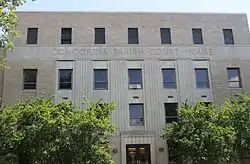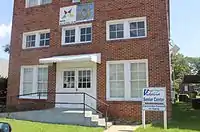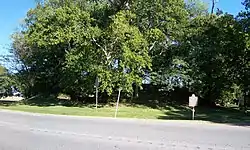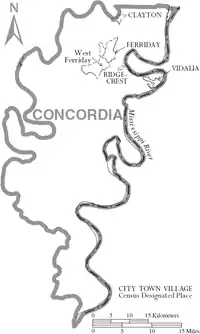Concordia Parish, Louisiana
Concordia Parish (Spanish: Parroquia de la Concordia; French: Paroisse de Concordia) borders the Mississippi River in eastern central Louisiana. As of the 2020 census, the population was 18,687.[1] The parish seat is Vidalia.[2] The parish was formed in 1807.[3]
Concordia Parish, Louisiana | |
|---|---|
| Parish of Concordia | |
 Old Concordia Parish Courthouse in Vidalia | |
 Location within the U.S. state of Louisiana | |
 Louisiana's location within the U.S. | |
| Country | |
| State | |
| Region | Central |
| Founded | 1807 |
| Named for | Possibly a land grant, New Concordia |
| Parish seat (and largest city) | Vidalia |
| Area | |
| • Total | 1,930 km2 (747 sq mi) |
| • Land | 1,810 km2 (697 sq mi) |
| • Water | 100 km2 (50 sq mi) |
| • percentage | 17 km2 (6.7 sq mi) |
| Population (2020) | |
| • Total | 18,687 |
| • Density | 9.7/km2 (25/sq mi) |
| Time zone | UTC-6 (CST) |
| • Summer (DST) | UTC-5 (CDT) |
| Area code | 318 |
| Congressional district | 5th |
| Website | www |
Concordia Parish is part of the Natchez, MS–LA Micropolitan Statistical Area. It is historically considered part of the Natchez District, devoted to cotton cultivation as a commodity crop, in contrast to the sugar cane crop of southern Louisiana. Other Louisiana parishes of similar character are East and West Carroll, Madison and Tensas, all in this lowlying delta land. On the east side of the Mississippi River is the Natchez District around the city of Natchez, Mississippi.[4]
History
Prehistory
Concordia Parish was the home to many successive Native American cultures for thousands of years before European encounter. Peoples of the Marksville culture, Troyville culture, Coles Creek culture and Plaquemine culture built villages and earthwork mound sites throughout the area. Notable examples include Cypress Grove Mound, DePrato Mounds, Frogmore Mound Site, and Lamarque Landing Mound.
Historic Native American tribes encountered by early French explorers and colonists were the following:
Historic era
Concordia was named by Anglo-American settlers for a Latin word meaning "harmony". They came mostly after the Louisiana Purchase of 1803, when the United States took over this formerly French colonial area west of the Mississippi. Like other parishes of the lands along the Mississippi River, in the antebellum era, the parish was developed for cotton cultivation on large plantations. The labor-intensive crop was profitable because of the labor of enslaved African Americans.
In 1789, Don Jose Vidal a resident of Natchez, MS and later the founder of the city of Vidalia, LA asked for land grants to move his family from Natchez to the other side of the Mississippi River. In Natchez, there was a mansion built called Concord (Natchez, Mississippi), this was a residence lived in by Spanish governors, also Vidal and his family lived there before the time era of the US began.
The Mansion started the name "Concord" and ultimately later led to the birth of what would be Concordia Parish. During the year of 1804, a ceremony of transfer was held and the citizens and Mayor of Natchez crossed over to the Louisiana side of the Mississippi to honor the new land that was founded. The Mansion was later struct by fire in the early 20th century (1901) and burned down. Natchez people also lived on both sides of the land.
"Concordia County" was a creation of the first Legislative Council held in New Orleans on December 2, 1804. Its territory that included parts of the present parishes of East Carroll, Madison, and Tensas.[5] Land between the Mississippi, Red, Black, and Tensaw rivers comprised the early local administration of Concordia.[6]
Because Concordia's alluvial soil was unusually productive for cotton growing, it attracted large plantations, whose owners enslaved a very high number of people. In 1860, slaves made up 91 percent of Concordia Parish's residents, the highest percentage of any Louisiana parish. Only two counties in the United States — Washington and Issaquena counties in Mississippi — had a higher percentage of its population enslaved.[7] As might be expected, the small number of white cotton planters in Concordia were fierce defenders of chattel slavery and strongly backed the Confederacy during the American Civil War.
Law and government
The current elected sheriff is David Hedrick.
The parish trends Democratic for local offices. For national offices, the majority has favored Republican candidates. In the 2008 presidential election, the Democrat Barack Obama of Illinois received 3,766 votes (39.5 percent) in Concordia Parish to 5,668 (59.5 percent) for the Republican nominee, John McCain of Arizona.[8] In 2004, Concordia Parish cast 5,427 votes (60 percent) for President George W. Bush and 3,446 ballots (38 percent) for his Democratic rival, Senator John F. Kerry of Massachusetts.
| Year | Republican | Democratic | Third party | |||
|---|---|---|---|---|---|---|
| No. | % | No. | % | No. | % | |
| 2020 | 5,550 | 62.87% | 3,177 | 35.99% | 101 | 1.14% |
| 2016 | 5,477 | 61.73% | 3,272 | 36.88% | 123 | 1.39% |
| 2012 | 5,450 | 58.10% | 3,833 | 40.86% | 97 | 1.03% |
| 2008 | 5,668 | 59.49% | 3,766 | 39.53% | 93 | 0.98% |
| 2004 | 5,427 | 60.43% | 3,446 | 38.37% | 107 | 1.19% |
| 2000 | 4,627 | 54.44% | 3,569 | 41.99% | 303 | 3.57% |
| 1996 | 3,134 | 35.96% | 4,565 | 52.38% | 1,016 | 11.66% |
| 1992 | 3,223 | 35.23% | 4,283 | 46.82% | 1,642 | 17.95% |
| 1988 | 5,037 | 57.49% | 3,461 | 39.50% | 263 | 3.00% |
| 1984 | 6,177 | 63.73% | 3,332 | 34.38% | 183 | 1.89% |
| 1980 | 4,933 | 54.20% | 3,956 | 43.46% | 213 | 2.34% |
| 1976 | 3,849 | 48.65% | 3,892 | 49.19% | 171 | 2.16% |
| 1972 | 4,521 | 64.37% | 2,142 | 30.50% | 360 | 5.13% |
| 1968 | 974 | 12.99% | 1,983 | 26.44% | 4,542 | 60.57% |
| 1964 | 4,022 | 83.25% | 809 | 16.75% | 0 | 0.00% |
| 1960 | 1,009 | 30.29% | 768 | 23.06% | 1,554 | 46.65% |
| 1956 | 841 | 39.74% | 699 | 33.03% | 576 | 27.22% |
| 1952 | 1,110 | 46.99% | 1,252 | 53.01% | 0 | 0.00% |
| 1948 | 98 | 6.25% | 329 | 21.00% | 1,140 | 72.75% |
| 1944 | 201 | 17.11% | 974 | 82.89% | 0 | 0.00% |
| 1940 | 119 | 9.21% | 1,173 | 90.79% | 0 | 0.00% |
| 1936 | 58 | 4.79% | 1,152 | 95.13% | 1 | 0.08% |
| 1932 | 20 | 1.96% | 999 | 98.04% | 0 | 0.00% |
| 1928 | 133 | 18.37% | 591 | 81.63% | 0 | 0.00% |
| 1924 | 46 | 12.60% | 319 | 87.40% | 0 | 0.00% |
| 1920 | 12 | 3.06% | 380 | 96.94% | 0 | 0.00% |
| 1916 | 10 | 3.61% | 264 | 95.31% | 3 | 1.08% |
| 1912 | 6 | 2.67% | 205 | 91.11% | 14 | 6.22% |
Geography


According to the U.S. Census Bureau, the parish has a total area of 747 square miles (1,930 km2), of which 697 square miles (1,810 km2) is land and 50 square miles (130 km2) (6.7%) is water.[10]
The parish is completely agricultural bottomlands. The Ouachita River runs along the west boundary, the Red River along the south, and the Mississippi River along the east. All three rivers are contained by large levee systems.
Major highways
Adjacent counties and parishes
- Tensas Parish (north)
- Adams County, Mississippi (northeast)
- Wilkinson County, Mississippi (east)
- West Feliciana Parish (southeast)
- Pointe Coupee Parish (south)
- Avoyelles Parish (southwest)
- Catahoula Parish (west)
National protected area
State protected area
Demographics
| Census | Pop. | Note | %± |
|---|---|---|---|
| 1820 | 2,626 | — | |
| 1830 | 4,662 | 77.5% | |
| 1840 | 9,414 | 101.9% | |
| 1850 | 7,758 | −17.6% | |
| 1860 | 13,805 | 77.9% | |
| 1870 | 9,977 | −27.7% | |
| 1880 | 14,914 | 49.5% | |
| 1890 | 14,871 | −0.3% | |
| 1900 | 13,559 | −8.8% | |
| 1910 | 14,278 | 5.3% | |
| 1920 | 12,466 | −12.7% | |
| 1930 | 12,778 | 2.5% | |
| 1940 | 14,562 | 14.0% | |
| 1950 | 14,398 | −1.1% | |
| 1960 | 20,467 | 42.2% | |
| 1970 | 22,578 | 10.3% | |
| 1980 | 22,981 | 1.8% | |
| 1990 | 20,828 | −9.4% | |
| 2000 | 20,247 | −2.8% | |
| 2010 | 20,822 | 2.8% | |
| 2020 | 18,687 | −10.3% | |
| U.S. Decennial Census[11] 1790-1960[12] 1900-1990[13] 1990-2000[14] 2010[15] | |||
2020 census
| Race | Number | Percentage |
|---|---|---|
| White (non-Hispanic) | 10,157 | 54.35% |
| Black or African American (non-Hispanic) | 7,477 | 40.01% |
| Native American | 39 | 0.21% |
| Asian | 115 | 0.62% |
| Other/Mixed | 440 | 2.35% |
| Hispanic or Latino | 459 | 2.46% |
As of the 2020 United States census, there were 18,687 people, 7,162 households, and 4,562 families residing in the parish.
2000 census
As of the census[17] of 2000, there were 20,247 people, 7,521 households, and 5,430 families residing in the parish. The population density was 29 inhabitants per square mile (11/km2). There were 9,148 housing units at an average density of 13 per square mile (5.0/km2). The racial makeup of the parish was 57.9% White, 40.7% Black or African American, 0.16% Native American, 0.3% Asian, 0.55% from other races, and 0.8% from two or more races. 1.2% of the population were Hispanic or Latino of any race.
There were 7,521 households, out of which 33.00% had children under the age of 18 living with them, 49.00% were married couples living together, 19.00% had a female householder with no husband present, and 27.80% were non-families. 25.30% of all households were made up of individuals, and 11.50% had someone living alone who was 65 years of age or older. The average household size was 2.60 and the average family size was 3.12.
In the parish the population was spread out, with 27.80% under the age of 18, 8.90% from 18 to 24, 25.60% from 25 to 44, 23.00% from 45 to 64, and 14.70% who were 65 years of age or older. The median age was 37 years. For every 100 females, there were 95.20 males. For every 100 females age 18 and over, there were 91.90 males.
The median income for a household in the parish was $22,742, and the median income for a family was $28,629. Males had a median income of $27,453 versus $18,678 for females. The per capita income for the parish was $11,966. About 24.30% of families and 29.10% of the population were below the poverty line, including 42.00% of those under age 18 and 20.60% of those age 65 or over.
Education
Concordia Parish School Board operates public schools in the parish.
Libraries
The Concordia Parish Library has 3 branches and a bookmobile service for all citizens of Concordia Parish.
- Ferriday Branch - 1609 Third Street, Ferriday, LA
- Vidalia Branch - 408 Texas Street, Vidalia, LA
- Clayton Branch - 31451 HWY-15 Clayton, LA
History
The Concordia Parish Library is the second oldest Parish Library in Louisiana and the first of such to be tax-supported.[18] The library began as a movement between the President of the Tri-Parish Community Organization who had obtained a community program and a State Librarian at the time, Essae Martha Culver. The two held a dinner where they launched a library movement in Concordia Parish. The Ferriday Rotary Club and Police Jury along with the public worked with the Louisiana Library Commission on the project and in October 1928 the Concordia Parish Demonstration Library was opened. Citizens of the parish voted to implement a tax to ensure the library could continue to function after seeing the advantages provided by the library. The library moved in 1952 to its present-day main building site in Ferriday, Louisiana. In that same year the interested clubs of Ferriday and the Parish Library, The Concordia Parish Police Jury turned the Community Center over to the Concordia Parish Library to be operated as a parish library for all citizens of Concordia under the supervision of the Concordia Parish Library Board.
Library Cards
The library serves the citizens who reside in the boundaries of Concordia Parish.[19] Any person permanently residing in Concordia Parish can use the services of a library with a library card. There are two types of library cards offered:
- Library Card: allows patrons to check out physical materials and use electronic services. This card requires two items of price of residents AND a photo identification. Card is issued without charge.
- Online Registration: allows access to Wi-Fi, public access, e-services, and downloadable databases.
National Guard
1086th Transportation Company of the 165th CSS (Combat Service Support) Battalion of the 139th RSG (Regional Support Group) is based in Vidalia, Louisiana on the west bank of the Mississippi River.
Notable people
Arts and entertainment
- Jerry Lee Lewis, musician
- Jimmy Swaggart, televangelist
- Mickey Gilley, musician
Journalism
- Campbell Brown, Emmy-award-winning journalist, CNN Anchor/host.
- Sam Hanna Sr., late publisher of Concordia Sentinel in Ferriday
- Howard K. Smith, ABC and CBS commentator
Politics
- Al Ater, State representative (1984–1988) and secretary of state (2005–2006)
- Leo Boothe, longest-serving District Judge of Concordia Parish and Catahoula Parish (1991−2015)
- Clifford Cleveland Brooks, planter in St. Joseph, represented Concordia Parish in the Louisiana State Senate from 1924 to 1932.[20]
- James H. "Jim" Brown, state senator (1972–1980), Louisiana secretary of state (1980–1988), and insurance commissioner (1992–2000)
- Charles C. Cordill, Louisiana state senator representing Concordia and Tensas parishes from 1884 to 1912[21]
- Noah W. Cross, Concordia Parish sheriff, 1944−1948; 1952−1973
- Brenham C. Crothers, Ferriday cattleman; state senator from delta parishes from 1948 to 1952 and 1956−1960
- Troyce Guice, U.S. Senate candidate, 1966 and 1986
- Bryant Hammett, state representative, 1992–2006
- Shelby M. Jackson, Education superintendent, 1948–1964
- Consuelo Montagu, Duchess of Manchester (1858−1909), spent part of her childhood at Ravenswood Place plantation, in the vicinity of Lake St. John.
- Ed Rand, late state representative (1960−1964) from Rapides Parish had a second home on Lake St. John.
- Dan Richey, state senator, 1980–1984
- Fred L. Schiele, state representative (1964−1968), Concordia Parish sheriff (1973−1980)
- J. Robert Wooley, state insurance commissioner (2000−2006); practiced law in Concordia Parish with James H. "Jim" Brown in late 1970s[22]
References
- "Census - Geography Profile: Concordia Parish, Louisiana". United States Census Bureau. Retrieved January 21, 2023.
- "Find a County". National Association of Counties. Archived from the original on May 31, 2011. Retrieved June 7, 2011.
- "Concordia Parish". Center for Cultural and Eco-Tourism. Retrieved September 6, 2014.
- John C. Rodrigue, Reconstruction in the Cane Fields: From Slavery to Free Labor in Louisiana's Sugar Parishes, 1862--1880, LSU Press, 2001, p. 176
- Calhoun, Robert Dabney. (1932). A history of Concordia Parish, Louisiana. (1768-1931). New Orleans, LA: n.p. pp. 33-34.
- Brackenridge, Henry Marie. (1817). Views of Louisiana: containing geographical, statistical, and historical notices of that vast and important portion of America. Baltimore: Schaeffer & Maund. Google Books website pp. 287-288.
- "Map showing the distribution of the slave population of the southern states of the United States. Compiled from the census of 1860". Library of Congress. Retrieved January 12, 2022.
- "Louisiana general election returns, November 4, 2008". sos.louisiana.gov. Retrieved June 15, 2010.
- Leip, David. "Dave Leip's Atlas of U.S. Presidential Elections". uselectionatlas.org. Retrieved March 7, 2018.
- "2010 Census Gazetteer Files". United States Census Bureau. August 22, 2012. Archived from the original on September 28, 2013. Retrieved August 27, 2014.
- "U.S. Decennial Census". United States Census Bureau. Retrieved August 27, 2014.
- "Historical Census Browser". University of Virginia Library. Retrieved August 27, 2014.
- "Population of Counties by Decennial Census: 1900 to 1990". United States Census Bureau. Retrieved August 27, 2014.
- "Census 2000 PHC-T-4. Ranking Tables for Counties: 1990 and 2000" (PDF). United States Census Bureau. Retrieved August 27, 2014.
- "State & County QuickFacts". United States Census Bureau. Archived from the original on June 6, 2011. Retrieved August 20, 2013.
- "Explore Census Data". data.census.gov. Retrieved December 29, 2021.
- "U.S. Census website". United States Census Bureau. Retrieved January 31, 2008.
- "History". concordialibrary.org.
- "Library Cards". concordialibrary.org.
- Henry E. Chambers, History of Louisiana, Vol. 2 (Chicago and New York City: The American Historical Society, Inc., 1925, p. 71)
- "Membership in the Louisiana State Senate, 1880-2012" (PDF). legis.state.la.us. Retrieved July 15, 2013.
- "Mike Hasten, "Louisiana insurance commissioner's race Wooley turns temporary job into a mission", November 7, 2003". capitolwatch.reallouisiana.com. Archived from the original on May 5, 2012. Retrieved June 18, 2013.
External links
- Heinrich, P. V., 2008, Woodville 30 x 60 minute geologic quadrangle. Louisiana Geological Survey, Baton Rouge, Louisiana.

